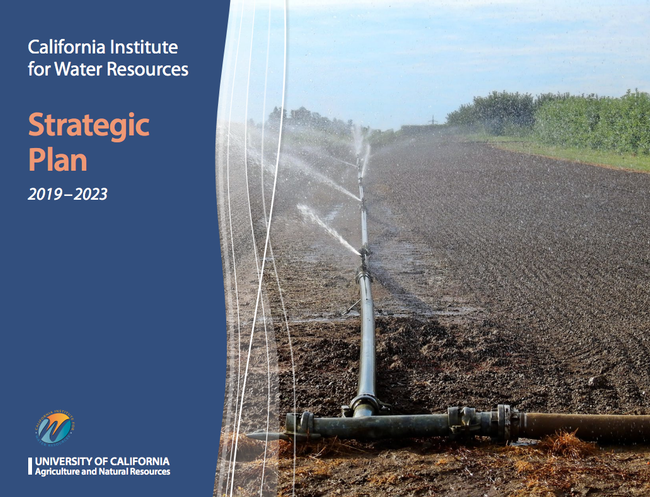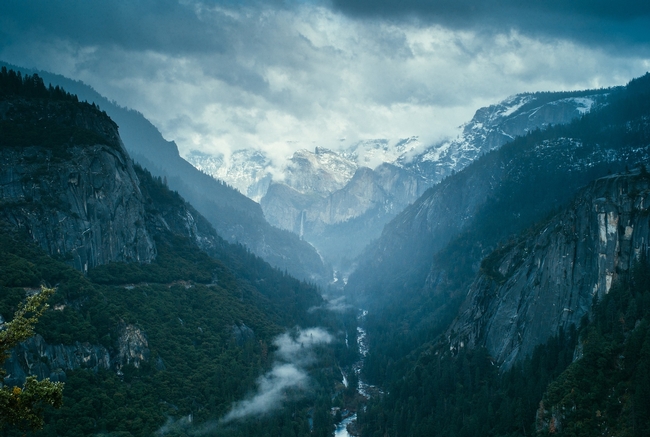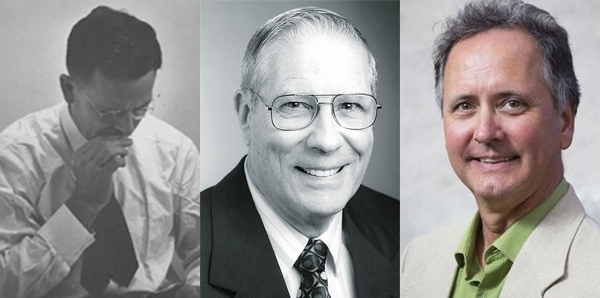Posts Tagged: California Institute for Water Resources
Water institute calls for research proposals
The California Institute for Water Resources invites submission of proposals to be considered for funding that will begin March 1, 2021.
This year, proposals are requested in the Junior Investigator category only. Funding is for up to two years. One-year proposals may request up to a total of $15,000, and two-year proposals may request up to $25,000 with a maximum of $15,000 in a given year.
Please note that the funding period may fluctuate and is contingent on state and federal budget appropriations.
The 2020-21 water resources research proposals are due Oct. 30, 2020, at 5 p.m.
Download the full RFP and budget worksheets (Word or PDF).
California Institute for Water Resources drafts new strategic plan
The committee was carefully selected to represent the diverse stakeholder interests of the institute. Through a variety of inputs during an assessment phase, which included several stakeholder surveys, committee members gathered information to help identify the strengths, opportunities and challenges of the organization to help formulate the plan. The final plan is a living document, which will be used as a flexible framework to develop annual priorities and evaluate progress.
The mission of the California Institute for Water Resources is to integrate California's research, extension and higher education programs to develop and communicate research-based solutions to water resource challenges. CIWR directly impacts California water issues through research and extension programs. The institute keeps its partners informed through its website, newsletter, blog and social media outlets and actively contributes, shapes and diversifies the conversation on California water issues. Meeting the objectives set forth in its strategic plan will increase the effectiveness of CIWR in helping California meet its future water challenges.
CIWR identified five strategic goals to focus on over the next five years:
- Foster and incubate research and extension focused on California's critical water challenges.
- Engage with and convene the water community to define and address California's water challenges.
- Enhance communication and engagement capacity and increase visibility.
- Strengthen the relationship between CIWR and UC ANR.
- Increase resources to better incubate research and engage the water community.
The complete plan is available at http://ucanr.edu/CIWRStrategicPlan or by visiting CIWR's website: http://ciwr.ucanr.edu.
Communication is key to action on California’s new water narrative
UC scientists, students and water agency professionals took a critical look inwards and a radical look outwards when they gathered in Sacramento in October to reimagine California water.
The event was the fourth annual gathering sponsored by UC ANR's California Institute for Water Resources and the University of California Water Security and Sustainability Research Initiative, UC Water.
While science is the hallmark of a research-oriented institution like UC, the participants were asked to recognize their important role not just as scientists but also communicators.
“We have a big role in educating the public,” said Roger Bales, engineering professor at UC Merced who has been active in water and climate research for more than 30 years. “Scientists are political actors. Facts do not speak for themselves.”
Felicia Marcus, chair of the California Water Resources Control Board and a conference panelist, asked the scientists to make their work accessible, and if they are uncomfortable with plain language, “write it both ways.”
“Complexity can lose people easily,” she said.
The conference keynote speaker, futurist Kim Stanley Robinson, also addressed the divide between scientific discourse and popular understanding, in particular when speaking about climate change.
“There is a strange disconnect between what the scientific community is telling the world and what the world is hearing. As a result of data analysis, science is announcing to the world there is climate change. Individuals cannot perceive climate change,” he said. “Show them in ways that can be understood by the senses. The story has to be told with pragmatism and common sense.”
The Reimagining California Water Conference pursued the water journey from the high-mountain headwaters of the Sierra Nevada to the vast groundwater basins in the valleys below. Over the last century, the mountains were blanketed with snow each winter, storing water that melted slowly in the spring and summer to provide a reliable source of water for farming and communities below. However, climate change is telling a new tale. Warmer weather means less snow and more rain will fall on the mountains during the winter. The quick runoff must be managed in a way that preserves it for use in the summer.
“We need groundwater recharge because we're losing the snow pack quicker than we thought we would,” Bales said.
The new California water narrative has prompted scientists and policymakers to take a serious look at the potential for “flood-managed aquifer recharge” or Flood-MAR. Flood-MAR is a management strategy that uses water from rain or snowmelt to flood agricultural lands and working landscapes, such as refuges, floodplains and flood bypasses.
Successful implementation of Flood-MAR requires the identification of land for groundwater recharge, understanding the economic and agronomic impact of using agricultural land for recharge, and impacts of high-volume recharge on groundwater quality. But the potential is enormous.
“The state's underground basins are capable of storing 500 million acre-feet of water,” said Graham Fogg, UC Davis professor of hydrogeology. “That's like 500 Folsom reservoirs.”
Though the enormity of rewriting the California water story might seem an insurmountable challenge, panelist Debbie Franco noted that the passage of Sustainable Groundwater Management in 2014 happened when the state's unsustainable reliance of groundwater spiked during the 2011-2016 drought, reducing municipal water quality, drying domestic wells and causing land to sink.
“What seems impossible, after four years of drought, can be possible,” Franco said. “What will be the next thing? Get a sense of the solutions now.”
Water-resources research proposals invited from junior investigators
The California Institute for Water Resources has announced its 2018-19 Request for Proposals. This year, proposals are requested in the junior investigator category only, said Doug Parker, director of the California Institute for Water Resources.
Funded projects will begin March 1, 2019. Please note that the funding period may fluctuate and is based on budget appropriations.
University of California ladder rank faculty and UC Cooperative Extension specialists and advisors who have been in their current position less than seven years are eligible. Eligibility is also extended to faculty members at other higher education institutions in California who have been in their current position less than seven years.
The deadline for submission is Oct. 26, 2018.
Visit the California Institute for Water Resources website to download the full RFP, including budget templates, at http://ciwr.ucanr.edu/Request_for_Proposals.
Water institute celebrates 60 years
The California Institute for Water Resources is celebrating its 60th anniversary.
To commemorate the changes and achievements of the institute, FaithKearns,CIWR academic coordinator II, wrote a Q&A with Doug Parker, CIWR director and leader of the Water Quality, Quantity, and Security Strategic Initiative.
Originally located at UCLA in 1957 and directed by Martin Huberty, over the years, the multi-campus research unit moved between the UC Berkeley, UC Davis, and UC Riverside campuses.
In 2011, ANR renamed UC Water Resources Center the California Institute for Water Resources and established its headquarters at the UC Office of the President in Oakland, where it remains today.
“The initial mission of the institute still stands: to integrate California's research, extension, and education programs to develop research-based solutions to water resource challenges,” Parker said. “In practice, we work across all kinds of institutions and provide educational programs through direct contact, web-based programs, and social media to increase understanding of complex water issues while also trying to diversify the conversation about water within our state.”
To read more about CIWR activities and key water issues that Parker sees ahead for the state, visit //ucanr.edu/blogs/blogcore/postdetail.cfm?postnum=25648.





